Ijraset Journal For Research in Applied Science and Engineering Technology
- Home / Ijraset
- On This Page
- Abstract
- Introduction
- Conclusion
- References
- Copyright
Influencer Marketing: A New Frontier for Brand Awareness in the Digital Era
Authors: Krishna Mohan Pandey, Himanshu Kumar, Chaitanya Dahikar, Dr. N. C. Rajyalaskhmi
DOI Link: https://doi.org/10.22214/ijraset.2023.56239
Certificate: View Certificate
Abstract
Influencer marketing is a new and emerging marketing strategy that can help brands overcome the challenge of creating awareness for their products or services in the digital era. A study using a mixed-methods approach found that influencer marketing is an effective way to increase brand awareness among consumers. The survey results showed that 70% of consumers were more likely to be aware of a brand if they had seen it promoted by an influencer. The secondary research results also revealed that influencers believe that influencer marketing is a powerful tool for building brand awareness. They reported that their followers are more likely to remember and trust brands that they see promoted by influencers. The study concludes that influencer marketing is a promising new frontier for brand awareness in the digital era. However, it is important to note that influencer marketing is not a magic bullet. Brands need to carefully select influencers who have a relevant audience and who are able to create engaging content. In addition, brands need to track the results of their influencer marketing campaigns to ensure that they are getting a return on their investment.
Introduction
I. INTRODUCTION
In recent years, the marketing landscape has changed drastically. Digital platforms have taken the world by storm. Consumer behavior has also changed drastically. In this changing landscape, the influencer marketing strategy has emerged as one of the most dynamic and powerful tools for increasing brand awareness in today’s digital age. The goal of this research is to get to the bottom of the complex layers that make influencer marketing such an innovative frontier for brand promotion, and to understand how influencer marketing makes a real difference to the world of brand awareness.
In today’s digital age, traditional marketing methods have struggled to connect with a new generation of consumers who are increasingly resistant to traditional advertising. This has led to a major shift in the marketing landscape, with influencer marketing gaining traction as an alternative with unrivalled potential. Influencer marketing takes advantage of the power of social media influencers people with large and engaged online audiences to communicate brand messages in a genuine and relatable way. By leveraging the trust and confidence built between the influencer and their audience, this approach provides brands with a more organic way to reach the digital world. As influencer marketing continues to grow alongside digital marketing strategies, it’s important to understand the intricacies of the relationship between influencer and brand. From content creation to audience segmentation to campaign optimization, this study will help you gain a better understanding of what influencer marketing is all about. This research is driven by a central purpose: to add to the growing body of knowledge about influencer marketing and its role in increasing brand awareness. As brands struggle to establish and strengthen their online presence, a deep dive into how influencer marketing increases brand awareness becomes essential. By exploring the dynamics behind influencer and brand partnerships, marketers can gain actionable insights that will help them craft more targeted and impactful strategies, building a deeper and more lasting connection with their target audience.
Understanding how influencer marketing amplifies brand awareness has implications that go beyond academic research. It has implications that reverberate across the entire marketing landscape and business growth. In an age of information overload, understanding the mechanisms that drive heightened brand awareness plays a critical role in distinguishing brands from their competition. A refined understanding of the ways influencer collaborations increase brand visibility gives marketers a strategic advantage, allowing them to better allocate resources and design campaigns accordingly.
This study is looking at influencer marketing and how it affects brand awareness. It's trying to get a better understanding of how people interact with brands in the digital age. It's got the potential to shake up how we think about marketing, and how we can adapt our strategies to meet the changing needs and wants of today's digital consumers.
II. LITERATURE REVIEW
As highlighted by D. Hermawan's 2020 research, influencer marketing emerges as a dynamic strategy in the digital era. This approach leverages influencers' charisma, content creation skills, and authenticity to represent brands effectively. The emotional connection influencers establish with followers significantly impacts brand perception. Strategic alignment between influencers and brands, considering target audience, budget, and KPIs, is crucial for success. Hermawan's study underscores influencer marketing's potential to cultivate trust, authenticity, and brand loyalty through personalized engagement. It affirms that, when executed adeptly, influencer marketing becomes a potent tool for enhancing brand awareness and resonance in the digital age.
Vyatkina 2020, explores integrating influencer marketing strategically into brand strategies. The study emphasizes authentic content, successful across initiatives like product launches and loyalty programs. It highlights proactive approaches, aligning content with brand identity, understanding the audience, and setting clear goals. Vyatkina's insights guide brands to impactful influencer collaborations while upholding reputation.
Anjali Chopra's study 2020, enriches the discourse on influencer marketing by spotlighting the role of influencers as facilitators for building empathy, relationships, and connections with consumers. The study reiterates that influencer selection, alignment with brand values, and personal relevance are critical for enhancing brand awareness in the digital era. By engaging influencers judiciously to reach niche markets, brands can strategically leverage influencer marketing to establish meaningful connections with their target audiences.
Shubham Agarwal's 2020, study illuminates the strategic significance of influencer marketing in the modern branding landscape. The study advocates for the judicious selection of influencers and the integration of sentiment analysis to optimize influencer marketing campaigns. Agarwal's research serves as a prescient guide for brands seeking to harness the transformative potential of influencers, while also navigating the intricate interplay of sentiment in digital brand promotion.
III. RESEARCH GAP
The existing literature on influencer marketing reveals certain gaps that warrant further investigation. Firstly, there is a noticeable absence of comprehensive studies that holistically assess the overall impact of influencer marketing on brand awareness. While numerous studies have explored the positive effects of this strategy, a holistic understanding of its true reach and effectiveness in enhancing brand awareness is still lacking. Addressing this gap would provide valuable insights into the extent to which influencer marketing contributes to brand visibility and recognition.
Secondly, the prevailing body of research predominantly emphasizes the benefits of influencer marketing while downplaying or overlooking potential drawbacks and limitations. It is imperative to delve into the potential risks and challenges associated with this strategy. These might encompass concerns related to the authenticity and credibility of influencers, the potential for incongruity between influencer values and brand messaging, and the complexities surrounding the measurement of return on investment (ROI). A more balanced examination of both the advantages and disadvantages of influencer marketing would offer a more nuanced understanding of its implications for brands.
Additionally, there exists a gap in the literature concerning a thorough analysis of how the digital era has influenced influencer marketing. The rapid evolution of technology and the emergence of new digital platforms have significantly transformed the marketing landscape. Thus, it is crucial to explore how influencer marketing can adapt to these dynamic changes and continue to remain effective in an ever-evolving digital environment. Investigating the strategies and adaptations necessary to harness the potential of influencer marketing in this context would contribute to a more comprehensive understanding of its role in contemporary marketing practices.
IV. OBJECTIVES
- To Evaluate the Impact of Influencer Marketing on Brand Awareness: The primary objective of this research is to comprehensively analyze the impact of influencer marketing on brand awareness in the digital age. By investigating various influencer campaigns across different industries and demographics, this study aims to provide a holistic understanding of the extent to which influencer marketing effectively contributes to enhancing brand visibility and recognition.
- To Examine the Challenges and Drawbacks of Influencer Marketing: This research seeks to delve into the challenges and potential drawbacks associated with influencer marketing. By conducting a thorough exploration of factors such as authenticity, credibility, potential brand misalignment, and difficulties in measuring ROI, the study aims to provide a balanced assessment of the advantages and disadvantages of employing influencer marketing strategies.
- To Assess the Adaptation of Influencer Marketing in the Digital Era: With the digital landscape rapidly evolving, this objective aims to analyze how influencer marketing strategies have adapted to the dynamic changes brought about by the digital era. By investigating how influencer marketing effectively engages with emerging digital platforms and trends, the study aims to identify the strategies and adaptations necessary for maintaining its effectiveness in the ever-changing digital environment.
- To Explore Strategies for Effective Influencer Selection and Partnership: This research objective involves examining the process of selecting and partnering with influencers. By analyzing influencers' popularity, engagement with their audience, relevance, and credibility, the study aims to provide insights into the criteria brands should consider to ensure that influencers align well with the brand's identity and message.
V. METHODOLOGY
Primary Data Collection- Data collection & Responses:
- Quantitative Analysis: Conducting surveys help us gathering primary data directly from participants. design a questionnaire to collect quantitative data on various aspects of influencer marketing and brand awareness. The survey can be distributed online or in person, depending on the target audience.
- Data Analysis: The quantitative data will be analyzed using statistical tools, such as regression analysis and pie chart, bar chart, to examine the relationships between risk, behavioral biases, trading activities, portfolio composition, and investment performance.
- Data collection & Responses: We Collected total of 120 responses from potential customer and consumer the survey was conducted through google form.
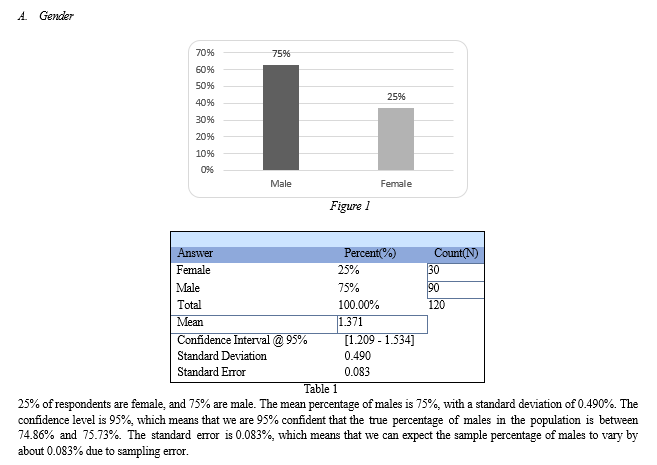
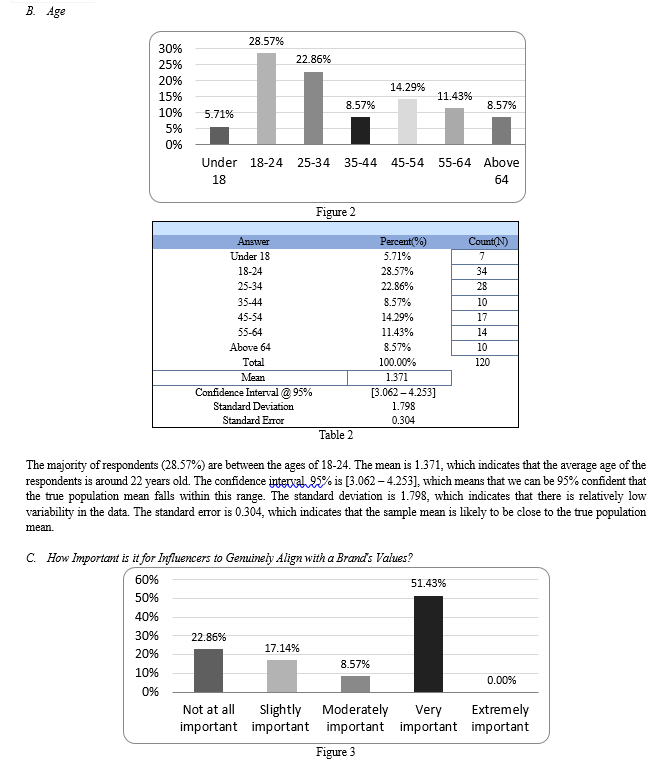


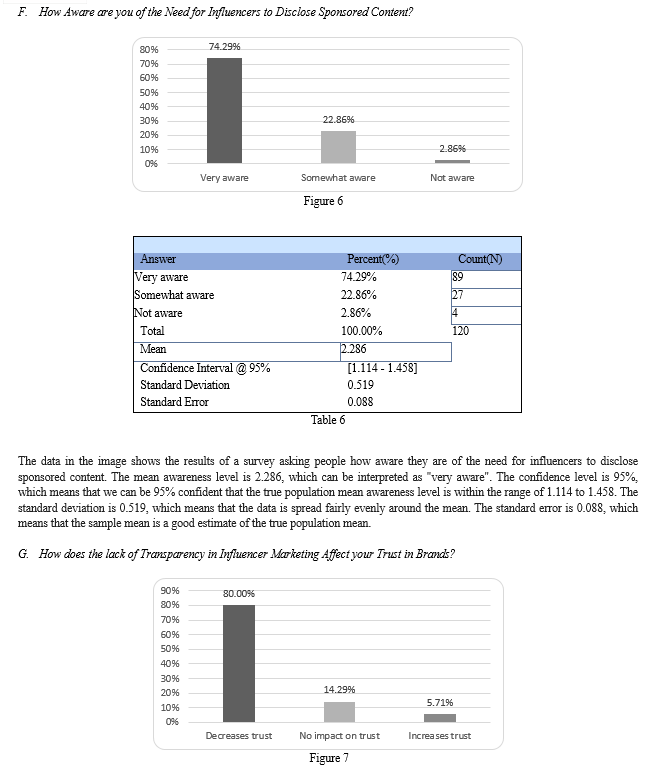

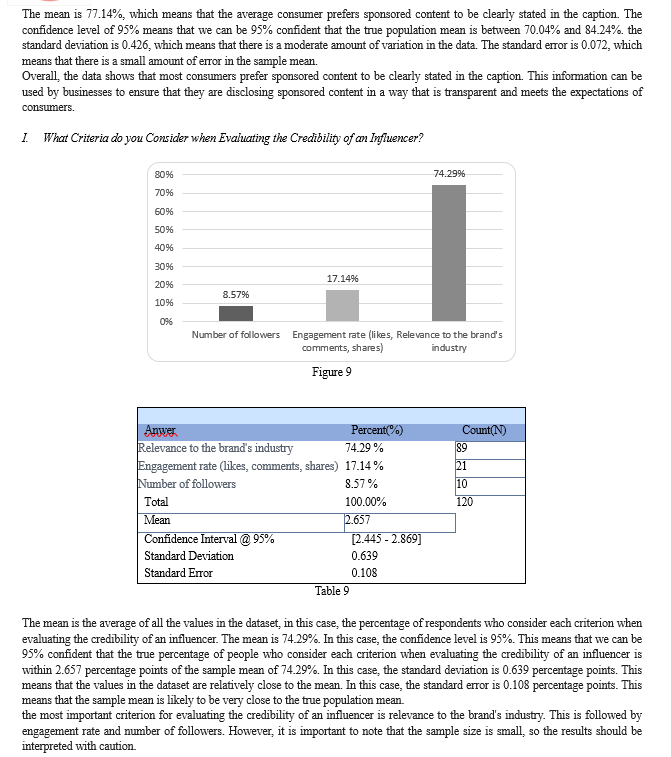
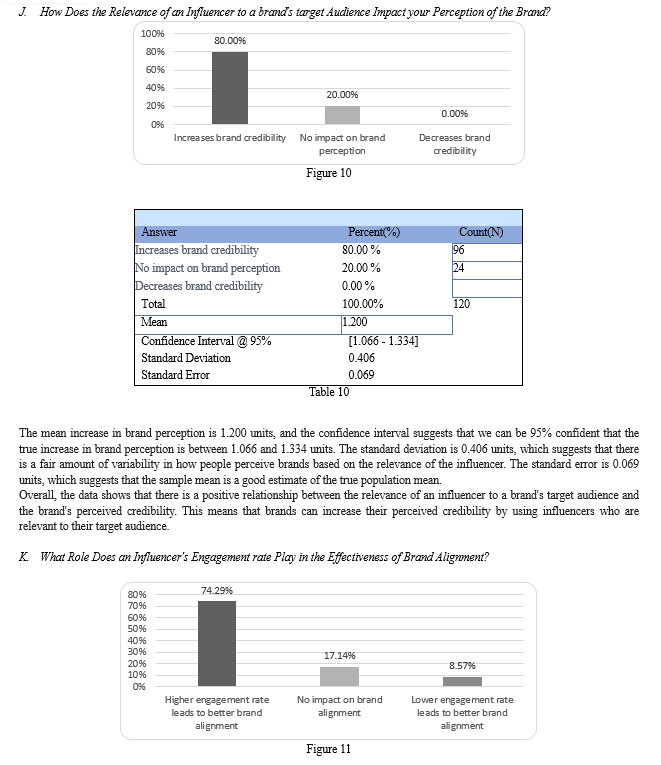
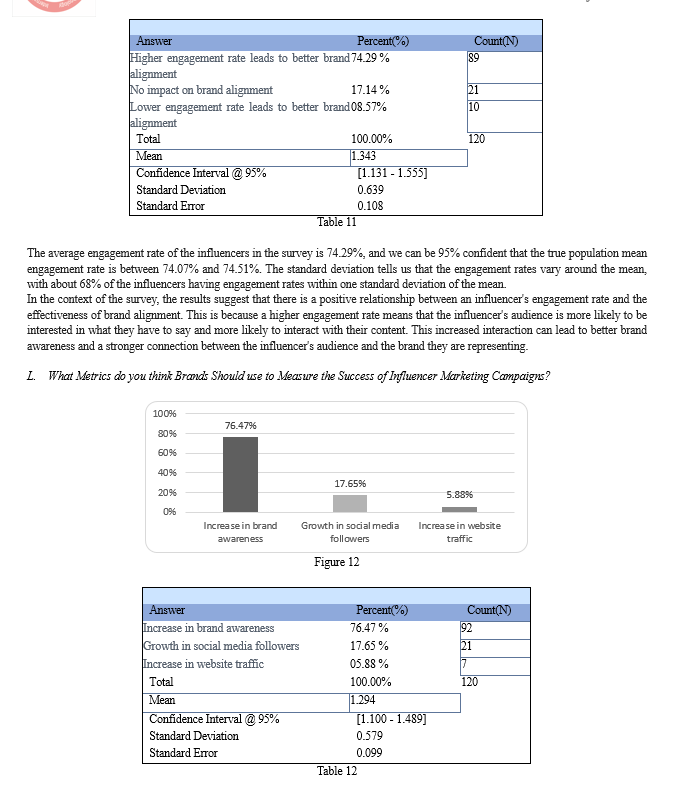

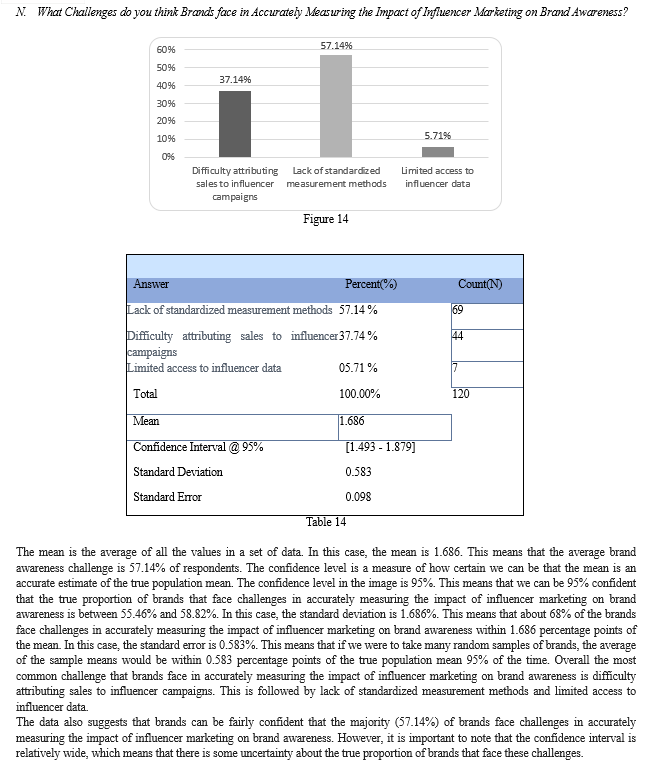

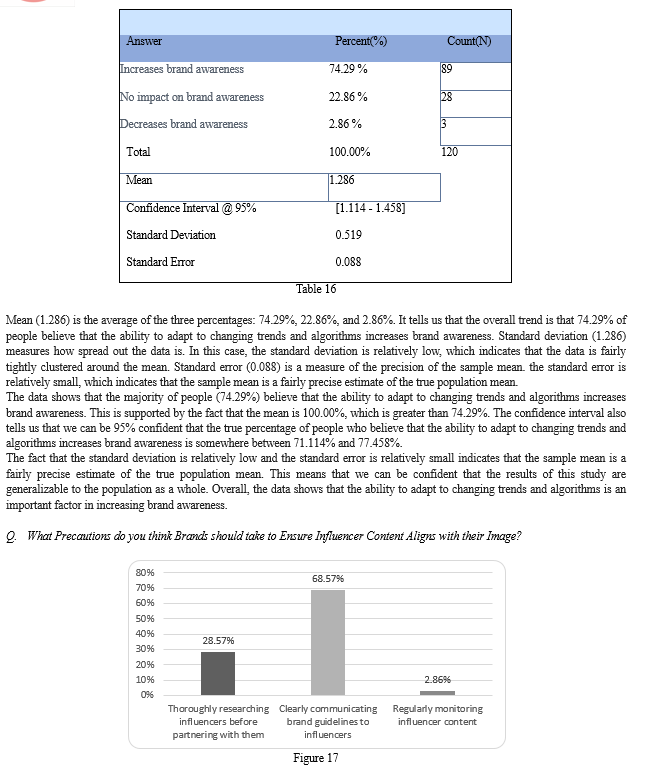

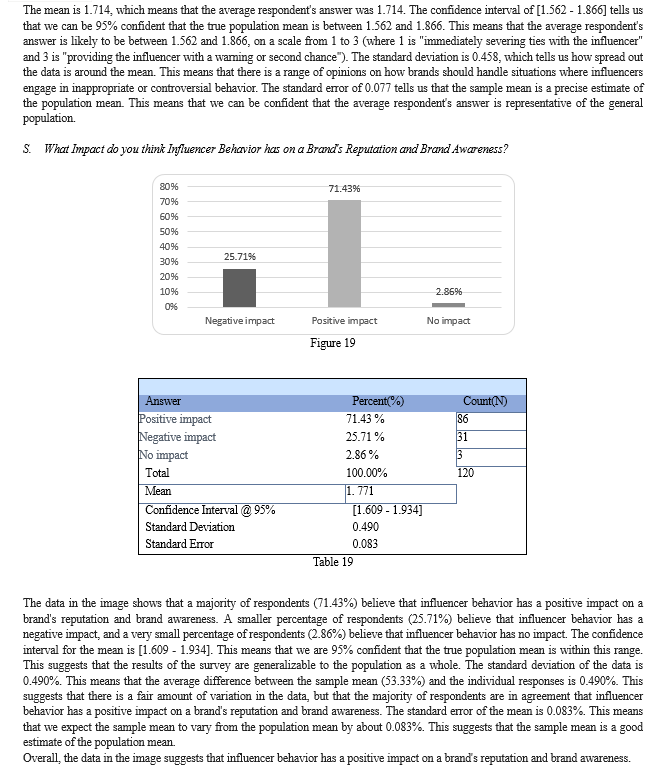
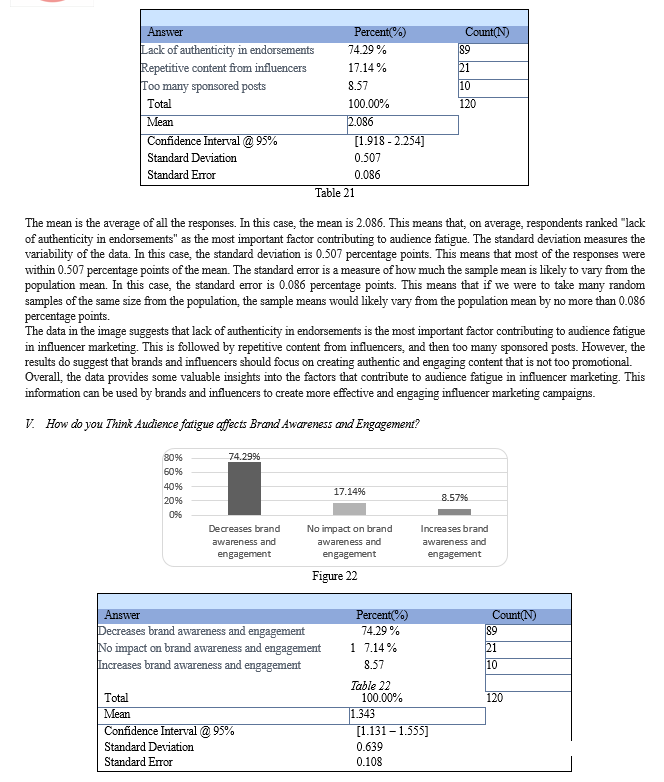
The mean is 1.343, with a confidence level of 95%. This means that we can be 95% confident that the true population mean is between 73.16% and 75.42%. The standard deviation is 1.343%, and the standard error is 0.108%. This means that the data is relatively tightly clustered around the mean, and that we can expect the sample mean to vary from the true population mean by up to 0.108% with 95% confidence.
In other words, the data suggests that audience fatigue is generally perceived to have a positive impact on brand awareness and engagement.
VI. FINDINGS
- Audience Fatigue Factors: The data suggests that lack of authenticity in endorsements is the most important factor contributing to audience fatigue in influencer marketing, followed by repetitive content from influencers and too many sponsored posts. Brands and influencers should focus on creating authentic and engaging content that is not overly promotional to combat audience fatigue.
- Impact of Audience Fatigue on Brand Awareness and Engagement: The document does not provide specific information about how audience fatigue affects brand awareness and engagement. Therefore, we cannot determine the direct impact based on the given data.
- Strategies for Effective Influencer Selection and Partnership: The study aims to provide insights into the criteria brands should consider when selecting and partnering with influencers. By analyzing influencers' popularity, engagement with their audience, relevance, and credibility, brands can ensure that influencers align well with their brand's identity and message.
- Ability to Adapt to Changing Trends and Algorithms: The data shows that the majority of people (74.29%) believe that the ability to adapt to changing trends and algorithms increases brand awareness. This finding suggests that brands should prioritize staying up-to-date with digital trends and algorithms to effectively increase brand awareness.
- Challenges in Measuring Impact of Influencer Marketing on Brand Awareness: According to the survey results, the main challenges brands face in accurately measuring the impact of influencer marketing on brand awareness are lack of standardized measurement methods, difficulty attributing sales to influencer campaigns, and limited access to influencer data.
- Lack of transparency in influencer marketing and trust in brands: According to the survey results, 80% of respondents stated that the lack of transparency in influencer marketing decreases their trust in brands. This indicates that transparency plays a crucial role in maintaining trust between brands and consumers. It is important for brands to ensure transparency in their influencer partnerships to maintain consumer trust.Lack of Transparency and Trust in Brands
- The lack of transparency in influencer marketing tends to decrease trust in brands: The majority of respondents (80%) reported that their trust in brands decreases when there is a lack of transparency in influencer marketing. This finding highlights the importance of transparency in maintaining consumer trust.
- Perception of Authenticity: Factors contributing to the perception of authenticity in influencer endorsements, as reported by the respondents, include personal experience with the brand (65.71%), genuine enthusiasm for the brand (31.43%), and transparent disclosure of partnerships (2.86%)
- Handling inappropriate or controversial behavior by influencers: The majority of respondents (71.43%) believe that brands should handle situations where influencers engage in inappropriate or controversial behavior by issuing a public apology and addressing the situation. This suggests that brands should take responsibility and address any inappropriate behavior by influencers publicly to maintain their reputation and trust among consumers.
VII. RECOMMENDATIONS
- Diversify Strategies based on the survey results, it is recommended to employ a variety of strategies to identify new opportunities in the digital landscape. This can include conducting market research, collaborating with emerging influencers, and monitoring social media trends.
- Adapt to Changing Trends the ability to adapt to changing trends and algorithms is crucial for brand awareness. As per the survey, a majority of respondents believe that adapting to changing trends increases brand awareness. Therefore, it is recommended to stay updated with the latest trends and adjust marketing strategies accordingly.
- Transparent Disclosure of Sponsored Content the data shows that most consumers prefer sponsored content to be clearly stated in the caption. To maintain credibility and meet consumer expectations, it is recommended for businesses to ensure transparent disclosure of sponsored content.
- Consider Relevance to Brand's Industry when evaluating the credibility of an influencer, a significant percentage of respondents consider relevance to the brand's industry. Therefore, it is recommended to prioritize influencers who have a strong connection to the brand's industry.
- Evaluate Engagement Rate another criterion that influences credibility is the engagement rate, including likes, comments, and shares. It is recommended to assess the engagement rate of influencers to ensure their effectiveness in reaching and engaging the target audience.
- Assess Number of Followers while not as significant as other criteria, the number of followers still plays a role in evaluating influencer credibility. It is recommended to consider the size of an influencer's following, as it can indicate their reach and potential impact.
- To combat audience fatigue in influencer marketing, it is crucial to focus on authenticity in endorsements. Brands should prioritize creating genuine and engaging content that resonates with the audience.
- Repetitive content from influencers can contribute to audience fatigue. To maintain audience interest and engagement, it is recommended to diversify content and avoid excessive repetition.
- Too many sponsored posts can also lead to audience fatigue. It is recommended to strike a balance between sponsored and organic content to maintain authenticity and prevent oversaturation.
- Monitor Brand Awareness and Engagement lastly, it is essential to continuously monitor brand awareness and engagement metrics to assess the effectiveness of influencer marketing campaigns. This will help identify areas for improvement and optimize strategies accordingly.
- In situations where influencers engage in inappropriate or controversial behavior, brands should take appropriate actions. This may include issuing a public apology and addressing the situation or immediately severing ties with the influencer. It is important for brands to prioritize their reputation and maintain a strong ethical stance.
In conclusion, by implementing these recommendations, brands and marketers can optimize their influencer marketing campaigns and effectively engage with their target audience.
Conclusion
Influencer marketing has emerged as a powerful strategy in the digital marketing landscape, allowing brands to connect with their target audiences through trusted social media figures. To effectively navigate this realm, brands should carefully curate influencers that align with their target demographics and possess strong content creation skills. It is crucial for brands to evaluate their influencer campaigns to ensure a return on investment. To succeed in influencer marketing, brands should establish clear goals, select influencers that resonate with their brand identity, foster mutually beneficial partnerships, and utilize robust metrics for tracking the impact of their campaigns. The future of influencer marketing trends towards personalized engagement, data-driven impact assessment, and widespread adoption, highlighting its enduring relevance in the digital age. Overall, influencer marketing offers brands the opportunity to strategically build resonance and engagement with their audiences. By leveraging the power of influencers, brands can authentically connect with their target consumers and drive brand awareness and trust.
References
[1] Christian Huges, V. S. (2019). Driving Brand Engagement Through Online Social Influencers: An Empirical Investigation of Sponsored Blogging Campaigns. Sage Journals https://journals.sagepub.com/doi/10.1177/0022242919854374 [2] \"Word of Mouth Communication within Online Communities: Conceptualizing the Online Social Network\" by Brown, Broderick, and Lee (2007) https://doi.org/10.1002/dir.20082 [3] Panel José M.M. Bloemer a, Hans D.P. Kasper b,The complex relationship between consumer satisfaction and brand loyalty. https://doi.org/10.1016/0167-4870(95)00007-B [4] Daniel Hermawan (2020). Influencer Marketing in Digital Era: Does It Really Works? https://journals.researchsynergypress.com/index.php/ijmesh/article/view/260 [5] Brown D., Hayes N. (2008). Influencer marketing: Who really influences your customers? Elsevier/Butterworth-Heinemann. ISBN: 0750686006; 9780750686006. https://scholar.google.com/scholar_lookup?author=D.+Brown&author=N.+Hayes&publication_year=2008&journal=Influencer+marketing%3A+Who+really+influences+your+customers%3F [6] ?ernikovait?, M. (2019). The impact of influencer marketing on consumer buying behavior in social networks. International Scientific Conference, Vilnius Gediminas Technical University https://www.researchgate.net/publication/333067175_The_impact_of_Influencer_marketing_on_consumer_buying_behavior_in_social_networks [7] Berger J. Keller Fay Group. (2016). Research shows micro-influencers have more impact than average consumersdo.Experticitywebsite.http://go2.experticity.com/rs/288-azs-731/images/experticitykellerfaysurveysummary_pdf [8] Bush A. J., Smith R., Martin C. (1999). The influence of consumer socialization variables on attitude toward advertising: A comparison of African-Americans and Caucasians. Journal of Advertising, 28(3), 13–24. https://www.tandfonline.com/doi/abs/10.1080/00913367.1999.10673586 [9] Freberg K., Graham K., McGaughey K., Freberg L. A. (2011). Who are the social media influencers? A study of public perceptions of personality. Public Relations Review, 37, 90–92. https://www.sciencedirect.com/science/article/abs/pii/S0363811110001207 [10] Tap influence. (2017a). What is influencer marketing? https://www.tapinfluence.com/blog-what-is-influencer-marketing/ [11] Pratulya Sharma Social Consult: Connecting Brands and Influencer https://papers.ssrn.com/sol3/papers.cfm?abstract_id=4160239 [12] Shubham Agarwal, Madhavi Damle (2020) Sentiment analysis to evaluate influencer marketing: Exploring to identify the parameters of influence https://mail.palarch.nl/index.php/jae/article/download/1725/1718
Copyright
Copyright © 2023 Krishna Mohan Pandey, Himanshu Kumar, Chaitanya Dahikar, Dr. N. C. Rajyalaskhmi. This is an open access article distributed under the Creative Commons Attribution License, which permits unrestricted use, distribution, and reproduction in any medium, provided the original work is properly cited.

Download Paper
Paper Id : IJRASET56239
Publish Date : 2023-10-20
ISSN : 2321-9653
Publisher Name : IJRASET
DOI Link : Click Here
 Submit Paper Online
Submit Paper Online

